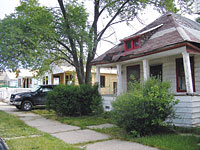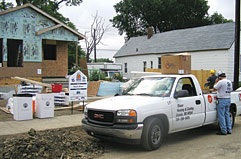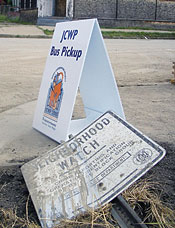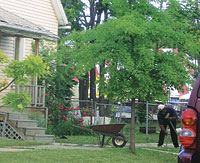
The broken windows theory comes from a strategy developed by James Q. Wilson and George Kelling using the example of a building with a few broken windows. If the windows are not repaired, they argued, the tendency is for vandals to break a few more windows. Crimes against the building escalate. Eventually, people may even break into the building, and, if it's unoccupied, perhaps become squatters or light fires inside.
By repairing the windows immediately, the crimes against the building can be reduced or prevented. The building can become a beacon of strength and redevelopment, infusing positive activity into an otherwise stagnant or dying community.
The founders of Habitat for Humanity use that same strategy. The organization's recent "Blitz Build" of 30 homes in Detroit marked the beginning of a hoped-for revitalization of a neighborhood pockmarked by vacant, rundown buildings and litter-strewn vacant lots.
I spent two days at the project, where I visited with HVAC contractors who volunteered their skills installing HVAC systems and worked as a volunteer at a home sponsored by The News' parent company, BNP Media. What I witnessed made me think of what this neighborhood and the volunteer HVAC contractors have in common - each is employing the broken windows theory.
While neighbors see how the new homes can revitalize the neighborhood and improve the value of their own properties, the general public can look to these contractors as positive symbols of the HVAC trade, doing what they can to undo any negative publicity about their trade.

Mending A Neighborhood
Willie Lindsay has seen a lot of changes in the 40 years he has lived in the neighborhood near the corners of West Grand Boulevard and Martin Luther King Boulevard. The neighborhood is marked by homes in various stages of decay - some occupied and some vacant. Some are meticulously well kept, standing next to others that appear ready to topple over at any moment.There is pride - and neglect - in the neighborhood.
Lindsay is one of the proud homeowners. He lives on Roosevelt Street, just a few doors away from where the Habitat for Humanity camp was set up. Giant circus-like tents and many trailers were visible at the end of the street. Ironically, Lindsay complained about all of the noise going on in the neighborhood - noise from generators and hammers. But he knew it would only last a week. His task, and those of his neighbors, is destined to last a lot longer.
On this day, Lindsay was replacing two concrete slabs in front of his home. He said he didn't want people tripping over the broken concrete. The man, in his 60s, was sweating profusely, digging up the ground where he would pour new cement. He was glad to do it, though, because he was happy to see the new homes going up in the neighborhood, bringing new neighbors and restoring a sense of pride among the long-time residents.
During my visit, I talked with several residents who were happy to see the flurry of new construction and the coming of new residents. In the middle of the project, a new children's playscape and park were erected. One young girl told me she was losing sleep waiting for the park to open. She had hope - something that comes without a price tag.

Restoring A Reputation
Craig Jones knows a good opportunity when he sees one. Last year, the president of the Southeast Michigan Air Conditioning Contractors of America (SEMIACCA) and co-owner of Slasor Heating & Cooling in Livonia, Mich., heard a tip from yours truly that Habitat for Humanity was conducting a Blitz Build in Detroit in June 2005.He realized it would be a good opportunity for local HVAC contractors to donate their time to a good cause, and hopefully to reap some of the good public relations that would come as a result.
Jones contacted fellow members of SEMIACCA, knowing that it would be a tough commitment for some businesses to ask employees to donate their time instead of being paid.
As it turned out, the bulk of the work was performed on a Sunday, when workers normally were off anyway. But the downside was that this particular Sunday was Father's Day. Despite that, five contractors were able to sign up six-person crews to spend the day installing ductwork and related components in six Habitat for Humanity homes.
The only guaranteed upside of the experience was the satisfaction that comes from helping others, but some contractors may benefit from the goodwill and positive publicity resulting from their participation.
I asked each contractor to send me a list of employees who worked on the project along with the name of their local newspaper. My intentions were to write a press release and send it to the newspaper, along with a photo. I did so, and followed up to help ensure that each newspaper tries its best to give each contractor the publicity it deserves.

That's a far cry from the usual summer news in many communities, where stings of local unethical HVAC employees caught ripping off consumers can result in high ratings points for local television stations.
Sometimes it seems that the small percentage of unscrupulous contractors leaves the biggest impression on the general public, thanks to investigative reports on television.
Negative publicity is like a few broken windows in a building - with each new sting, the reputation of our HVAC trade takes another hit, and public distrust deepens.
The members of SEMIACCA, as well as other Detroit-area HVAC contractors, were goodwill ambassadors for the industry during the Blitz Build project. Their hard work was a perfect example of hor to repair the damage and put the broken windows theory to work, with positive results.
If your company is doing something positive in your community, drop me a line. I'd be happy to let the local media know.
John R. Hall is business management editor. He can be reached at 734-464-1970, 248-786-1390 (fax), or johnhall@achrnews.com.
Publication date: 07/18/2005
Report Abusive Comment